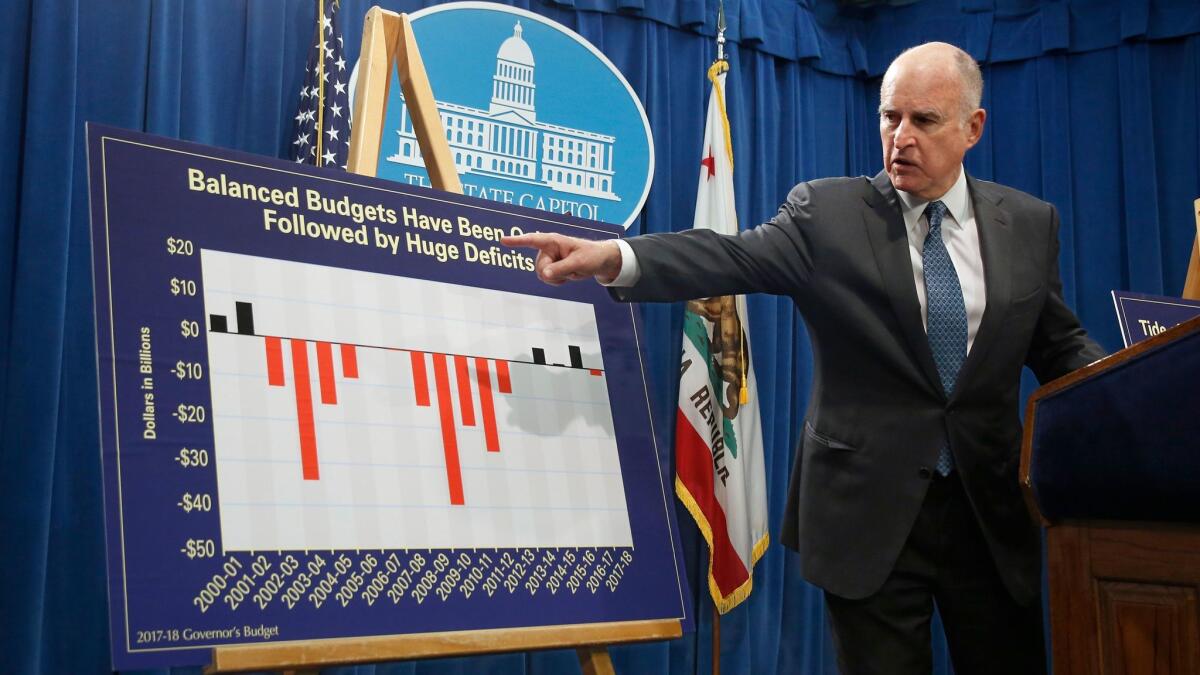After a bumpy tax report and unsettled politics, all eyes turn to Gov. Jerry Brown’s revised budget

Reporting from Sacramento — The four months since Gov. Jerry Brown submitted his state budget plans to lawmakers have been some of the most unusual in recent Sacramento history. Rarely have a winter and spring been so politically unsettled, thanks to a jumble of thinly veiled threats over federal dollars and one crucial month of surprisingly weak tax revenue collections.
The disruption has shifted much of the focus in the state Capitol away from traditional debates over taxes and spending — a distraction that will briefly fade starting on Thursday, as Brown sends the Legislature a revised spending plan.
For the record:
9:57 p.m. Nov. 15, 2024An earlier version of this article stated that Gov. Jerry Brown would send legislators a revised budget on Wednesday. He will send it to them on Thursday.
“We’ve got a lot of priorities, from education to the environment and healthcare that we want to keep pushing,” said Assemblyman Phil Ting (D-San Francisco), the Assembly’s budget committee chairman.
The odds seem low, lawmakers and advocacy group leaders say, that the governor will radically restructure his January blueprint, a $179.5-billion proposal for California’s fiscal year that begins July 1. On the most wide-ranging issue — the financial impact of major policy changes by President Trump — Brown has been steadfast that any state action should only be taken once there’s clarity about what actually will happen.
“There are so many ‘iffy’s’ out there, that it’s a very highly speculative thing,” the governor said in an interview while visiting Washington in late March. “Whatever comes up, we’ll have to deal with it.”
The flames were fanned early in the year by Trump himself, saying in a national TV interview that California’s liberal Democratic leaders were “out of control,” and threatening to defund some services in the state. Squabbles have continued over funds provided to so-called sanctuary cities that decline to help federal agents in tracking down immigrants who are in the U.S. illegally.
Most pressing for Brown and lawmakers, though, is something the federal government is not responsible for: a projected $1.6-billion deficit, the first potential shortfall in four years. Lawmakers have suspected much of that may be due to an error in calculating the costs of Medi-Cal, the program that provides healthcare to low-income Californians.
The math mistake, revealed in January, may have surprisingly been the least of the state’s headaches about Medi-Cal. The $102.6-billion program, now providing medical care to some 13.5 million Californians, could suffer severe cuts under the healthcare bill approved by House Republicans last week.
No state more eagerly embraced provisions in the Affordable Care Act than California when it came to using federal money in expanded healthcare for the poor. That expansion is expected to cost $20 billion in the state’s upcoming budget year, with all but about $900 million paid by the federal government.
The initial version of the GOP health plan, on the other hand, was projected to cut $24 billion from the state’s program within a decade.
“It blows a hole in our state budget,” said Anthony Wright, executive director of the advocacy group Health Access California.
Brown has insisted it would premature to launch an effort to combat the proposed changes until they become settled law.
“The first idea is to do everything to prevent it from happening,” he said in late March.
Political Road Map: Does the state spend more money on K-12 schools or prisons? »
Instead, the governor has focused on the more immediate budget shortfall. His original plan called for canceling some assumed expenses like a one-time infusion of cash for affordable housing, as well as ratcheting down the projected growth in K-12 education spending. He also proposed using revenue generated by the state’s new tobacco tax increase, Proposition 56, to more broadly cover healthcare programs than supporters had expected.
The ballot measure promised that the higher tobacco taxes would boost provider payments for doctors who treat Medi-Cal patients. California has some of the lowest rates in the nation.
“It is critical that patients not only have Medi-Cal coverage, but that they also have access to providers that accept Medi-Cal,” Rep. Raul Ruiz (D-Palm Desert) said to Brown last week in a letter that was signed by 38 Democrats in the state’s congressional delegation.
Brown argues that critics fail to realize that canceling the shift in Medi-Cal funds will only create the need for more cuts elsewhere.
“Taking the tobacco money, and using it to plug a hole, is less burdensome than increasing [physician] provider rates but then cutting back on childcare, cutting higher education,” he said in March.
Even as California’s economy has strengthened and tax revenues have remained strong, the governor has sought to portray the state’s finances as stretched thin. His case may have been bolstered by a report Monday from the Legislative Analyst’s Office that that the month’s income tax collections missed the mark by $922 million — higher than estimated just two weeks ago. Previous months’ revenue came in higher than expected, though — effectively returning the revenue trends back toward the governor’s longer-term forecast.
“While April didn’t look great, it really just brought us back to where we were,” said Ryan Miller, a fiscal researcher in the analyst’s office.
Lawmakers are also eager to see whether Brown’s revised budget still includes a $622-million shift in costs from the state to counties for care provided by the In-Home Supportive Services program, which provides care for elderly and disabled. Lawmakers hope he’ll reconsider the plan, or at least lessen its fiscal impact to local government.
The governor’s submission of a revised plan will come exactly five weeks before the constitutional deadline for the Legislature to pass a spending plan — a deadline routinely missed until voters changed the rules in 2010. Now budgets are subject to a simple majority vote of legislators whose salaries can be garnished for every day past the June 15 deadline that it takes to complete the work.
Follow @johnmyers on Twitter, sign up for our daily Essential Politics newsletter and listen to the weekly California Politics Podcast
ALSO:
California’s budget deficit is back, says Gov. Jerry Brown
Updates on California politics
More to Read
Get the L.A. Times Politics newsletter
Deeply reported insights into legislation, politics and policy from Sacramento, Washington and beyond. In your inbox three times per week.
You may occasionally receive promotional content from the Los Angeles Times.











